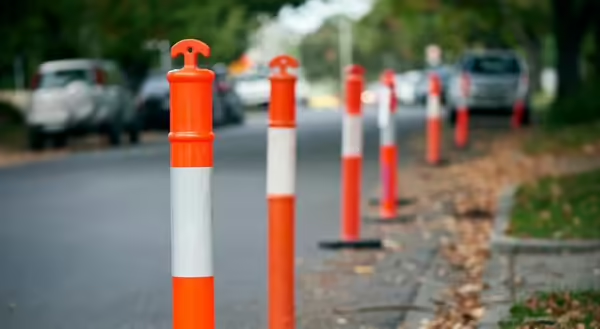
On January 1, 2025, a new law went into effect that could affect Illinois’ pesticide applicators working in rights-of-way areas. The Illinois Department of Agriculture (IDOA) has been tasked with writing the rules and has recently created a page on their website dedicated to communicating with those affected by this law.
The Pesticide Application on Rights-of-Way Notification Act (PARNA) Public Act 103-0976 regulates the use of pesticides in municipalities. This Act requires that municipalities and government entities provide 24 hours of notice to the public before applying a pesticide on a public right-of-way within the corporate boundaries of a municipality. Additionally, commercial applicators hired by these local governments to make these applications must abide by notification requirements as well.
In short, the notice must include location and date of intended applications, name and type of pesticide to be used, reason for use, concentrations, any special instructions, name and telephone number of the applicator, and the contact information for the Illinois Department of Agriculture. The notice must be in writing and posted at least 24 hours before the intended application. Written notice is sufficient if posted in newsletters, websites, calendars or other correspondence currently published by the government entity. Posting on a bulletin board is not sufficient.
University of Illinois PSEP has been making applicators at this winter’s in-person Rights-of-Way clinics aware of this. Certainly, there has been no shortage of questions surrounding it. Many wonder if they are included, what method they will use for providing notification, and how frequently they will need to give notice. The Illinois Department of Agriculture has indicated that they realize that not everyone knows this news yet, but they are working to improve that. For now, they want applicators to make a good faith effort. For example, it might make sense to give notice for applications that are planned for a given week but notice that applications will be made “in May and June” really wouldn’t be sufficient. This wouldn’t have to be a daily task and things happen. Scheduled applications are sometimes cancelled or delayed due to weather or other reasons. That’s fine. Again, do your best. If a website or newsletter isn’t an option, a Google calendar made available to the public could be an easy, inexpensive solution. Also, to clarify, this act covers outdoor applications only.
The Act and IDOA provide these definitions for further clarification:
Unit of Local Government
Means a unit of local government, as defined in Article VII, Section 1 of the Illinois Constitution, except a park district, forest preserve district or conservation district.
Illinois Constitution, Article VII (Local Government), Section 1 (Municipalities and Units of Local Government)
"Units of local government" means counties, municipalities, townships, special districts, and units, designated as units of local government by law, which exercise limited governmental powers or powers in respect to limited governmental subjects, but does not include school districts.
Note some exemptions in the Act:
Park Districts, Forest Preserve Districts, Conservation Districts and School Districts are exempt from the requirements of this Act.
Also exempt are applications of solid mosquito larvicide and mosquito control applications in response to (i) disease causing agents in vector mosquitoes, (ii) the occurrence of mosquito-borne disease in animal or human populations, or (iii) a natural disaster recovery effort.
Who has to give notice?
The State or a unit of local government or a commercial entity hired by the State or local unit of government who applies a pesticide to a public right-of-way that is located within the corporate boundaries of a municipality.
This includes mosquito abatement districts making applications to control mosquitos.
When must notice be given?
Notice must be given at least 24 hours before the application.
What forms of notice are acceptable?
Written notification is sufficient if posted in newsletters, websites, calendars or other correspondence currently published by the state or local entity in which the application is to be made.
Posting on a bulletin board is not sufficient.
What must be included in the notice?
- The intended location, date range and range of times during the day that the material may be applied;
- The brand name, common name, and scientific name of each product that may be applied;
- The type of pesticide contained in any product that may be applied;
- The reason for use of each product that may be applied;
- The range of concentrations of any end-use product that will be applied;
- Any special instructions appearing on the label of the product applicable to an individual's use of the public right-of-way following an application;
- The State agency, mosquito abatement district, or other unit of local government name and telephone number of the certified applicator;
- Contact information for the Illinois Department of Agriculture's Pesticide Misuse Section, including a telephone number and website information for the Department (provided below).
Contact information for the Illinois Department of Agriculture - Pesticide Misuse Section:
Illinois Department of Agriculture Bureau of Environmental Programs
217-785-2427
800-641-3934 (Pesticide Hotline)
Pesticide Misuse Webpage and Complaint Form
Thank you for your continued patience while everything is sorted out with this new rule. If you have questions, please check the Illinois Department of Agriculture’s website for updates. Their staff is also available to assist at the above phone number or by emailing AGR.Pesticide@illinois.gov.
Image credit: AdobeStock
ABOUT THE AUTHORS: Michelle Wiesbrook provides subject matter expertise and training in pesticide safety with an emphasis on horticultural weed science. She serves as the Illinois Pesticide Review newsletter editor, collecting and organizing material.